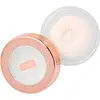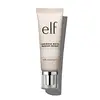What's inside
What's inside
 Key Ingredients
Key Ingredients

 Benefits
Benefits

 Concerns
Concerns

 Ingredients Side-by-side
Ingredients Side-by-side

Cyclopentasiloxane
EmollientDimethicone
EmollientDimethicone/Vinyl Dimethicone Crosspolymer
Skin ConditioningHydrogenated Vegetable Oil
EmollientPentaerythrityl Tetraisostearate
EmollientVinyl Dimethicone/Methicone Silsesquioxane Crosspolymer
Mica
Cosmetic ColorantDisteardimonium Hectorite
StabilisingPEG-10 Dimethicone
Skin ConditioningPPG-25-Laureth-25
EmulsifyingSilica Dimethyl Silylate
EmollientSilica
AbrasiveWater
Skin ConditioningTocopheryl Acetate
AntioxidantParfum
MaskingTrimethylsiloxysilicate
EmollientDiethylhexyl Syringylidenemalonate
Skin ProtectingAscorbyl Palmitate
AntioxidantPropylene Glycol
HumectantCaprylic/Capric Triglyceride
MaskingSodium Cocoyl Alaninate
Butylene Glycol
HumectantGlyceryl Stearate
EmollientCitric Acid
BufferingHydrolyzed Collagen
EmollientTriethoxycaprylylsilane
Hydrolyzed Elastin
EmollientCetyl Hydroxyethylcellulose
Emulsion StabilisingRutin
AntioxidantPalmitoyl Tetrapeptide-7
Skin ConditioningPalmitoyl Tripeptide-1
Skin ConditioningPhaseolus Lunatus Seed Extract
EmollientPhenoxyethanol
PreservativeLimonene
PerfumingLinalool
PerfumingCitral
PerfumingHexyl Cinnamal
PerfumingHydroxycitronellal
PerfumingCI 77891
Cosmetic ColorantCI 75470
Cosmetic ColorantCyclopentasiloxane, Dimethicone, Dimethicone/Vinyl Dimethicone Crosspolymer, Hydrogenated Vegetable Oil, Pentaerythrityl Tetraisostearate, Vinyl Dimethicone/Methicone Silsesquioxane Crosspolymer, Mica, Disteardimonium Hectorite, PEG-10 Dimethicone, PPG-25-Laureth-25, Silica Dimethyl Silylate, Silica, Water, Tocopheryl Acetate, Parfum, Trimethylsiloxysilicate, Diethylhexyl Syringylidenemalonate, Ascorbyl Palmitate, Propylene Glycol, Caprylic/Capric Triglyceride, Sodium Cocoyl Alaninate, Butylene Glycol, Glyceryl Stearate, Citric Acid, Hydrolyzed Collagen, Triethoxycaprylylsilane, Hydrolyzed Elastin, Cetyl Hydroxyethylcellulose, Rutin, Palmitoyl Tetrapeptide-7, Palmitoyl Tripeptide-1, Phaseolus Lunatus Seed Extract, Phenoxyethanol, Limonene, Linalool, Citral, Hexyl Cinnamal, Hydroxycitronellal, CI 77891, CI 75470
Water
Skin ConditioningCyclopentasiloxane
EmollientDimethicone/Vinyl Dimethicone Crosspolymer
Skin ConditioningDimethicone
EmollientPEG-10 Dimethicone
Skin ConditioningIsodecyl Neopentanoate
EmollientCyclohexasiloxane
EmollientButylene Glycol
HumectantDimethiconol
EmollientDisteardimonium Hectorite
StabilisingPropylene Carbonate
SolventTriethoxycaprylylsilane
Sodium Chloride
MaskingTitanium Dioxide
Cosmetic ColorantPhenoxyethanol
PreservativeEthylhexylglycerin
Skin ConditioningPropanediol
SolventPhenethyl Alcohol
MaskingUndecyl Alcohol
AntiseborrhoeicTocopherol
AntioxidantSilica
AbrasiveRetinyl Palmitate
Skin ConditioningSodium Ascorbyl Phosphate
AntioxidantTocopheryl Acetate
AntioxidantVitis Vinifera Seed Oil
EmollientEuterpe Oleracea Fruit Oil
Skin ConditioningWater, Cyclopentasiloxane, Dimethicone/Vinyl Dimethicone Crosspolymer, Dimethicone, PEG-10 Dimethicone, Isodecyl Neopentanoate, Cyclohexasiloxane, Butylene Glycol, Dimethiconol, Disteardimonium Hectorite, Propylene Carbonate, Triethoxycaprylylsilane, Sodium Chloride, Titanium Dioxide, Phenoxyethanol, Ethylhexylglycerin, Propanediol, Phenethyl Alcohol, Undecyl Alcohol, Tocopherol, Silica, Retinyl Palmitate, Sodium Ascorbyl Phosphate, Tocopheryl Acetate, Vitis Vinifera Seed Oil, Euterpe Oleracea Fruit Oil
Ingredients Explained
These ingredients are found in both products.
Ingredients higher up in an ingredient list are typically present in a larger amount.
Butylene Glycol (or BG) is used within cosmetic products for a few different reasons:
Overall, Butylene Glycol is a safe and well-rounded ingredient that works well with other ingredients.
Though this ingredient works well with most skin types, some people with sensitive skin may experience a reaction such as allergic rashes, closed comedones, or itchiness.
Learn more about Butylene GlycolCyclopentasiloxane, or D5, is a silicone used to improve texture of products and trap moisture.
D5 is considered lightweight and volatile. Volatile means it evaporates quickly after application. Once evaporated, D5 leaves a thin barrier that helps keep skin hydrated.
It is also an emollient. Emollients help soften the skin and prevent water loss. Silicones create a silky texture in products. D5 helps other ingredients become more spreadable.
Studies show D5 is safe to use in skincare products. We recommend speaking with a skincare professional if you have concerns.
Learn more about CyclopentasiloxaneDimethicone is a type of synthetic silicone created from natural materials such as quartz.
What it does:
Dimethicone comes in different viscosities:
Depending on the viscosity, dimethicone has different properties.
Ingredients lists don't always show which type is used, so we recommend reaching out to the brand if you have questions about the viscosity.
This ingredient is unlikely to cause irritation because it does not get absorbed into skin. However, people with silicone allergies should be careful about using this ingredient.
Note: Dimethicone may contribute to pilling. This is because it is not oil or water soluble, so pilling may occur when layered with products. When mixed with heavy oils in a formula, the outcome is also quite greasy.
Learn more about DimethiconeThis ingredient is a silicone used to improve the texture of products and absorb oil. It does not get absorbed into the skin.
Like other silicones, Dimethicone/Vinyl Dimethicone Crosspolymer helps condition the skin by creating a barrier. In this sense, it can act as an emollient and trap moisture in.
This ingredient is a type of elastomer.
Learn more about Dimethicone/Vinyl Dimethicone CrosspolymerDisteardimonium Hectorite comes from the clay mineral named hectorite. It is used to add thickness to a product.
It can also help stabilize a product by helping to disperse other ingredients.
Hectorite is a rare, white clay mineral.
Learn more about Disteardimonium HectoritePeg-10 Dimethicone is silicone with conditioner and emulsifier properties. It mostly acts as an emollient in skincare and and humectant in haircare.
According to the manufacturer, acidic formulations decrease the stability of this ingredient. It works best in neutral or near neutral formulations.
Phenoxyethanol is a preservative that has germicide, antimicrobial, and aromatic properties. Studies show that phenoxyethanol can prevent microbial growth. By itself, it has a scent that is similar to that of a rose.
It's often used in formulations along with Caprylyl Glycol to preserve the shelf life of products.
Silica, also known as silicon dioxide, is a naturally occurring mineral. It is used as a fine, spherical, and porous powder in cosmetics.
Though it has exfoliant properties, the function of silica varies depending on the product.
The unique structure of silica enhances the spreadability and adds smoothness, making it a great texture enhancer.
It is also used as an active carrier, emulsifier, and mattifier due to its ability to absorb excess oil.
In some products, tiny microneedles called spicules are made from silica or hydrolyzed sponge. When you rub them in, they lightly polish away dead skin layers and enhance the penetration of active ingredients.
Learn more about SilicaTocopheryl Acetate is AKA Vitamin E. It is an antioxidant and protects your skin from free radicals. Free radicals damage the skin by breaking down collagen.
One study found using Tocopheryl Acetate with Vitamin C decreased the number of sunburned cells.
Tocopheryl Acetate is commonly found in both skincare and dietary supplements.
Learn more about Tocopheryl AcetateTriethoxycaprylylsilane is a silicone used to bind and stabilize ingredients.
As an emulsifier, it helps prevent ingredients from separating. This can help elongate the shelf life of products.
Triethoxycaprylylsilane is often used to coat mineral sunscreens ingredients to help give a better feel. It also helps reduce oxidative stress in sunscreens.
Learn more about TriethoxycaprylylsilaneWater. It's the most common cosmetic ingredient of all. You'll usually see it at the top of ingredient lists, meaning that it makes up the largest part of the product.
So why is it so popular? Water most often acts as a solvent - this means that it helps dissolve other ingredients into the formulation.
You'll also recognize water as that liquid we all need to stay alive. If you see this, drink a glass of water. Stay hydrated!
Learn more about Water